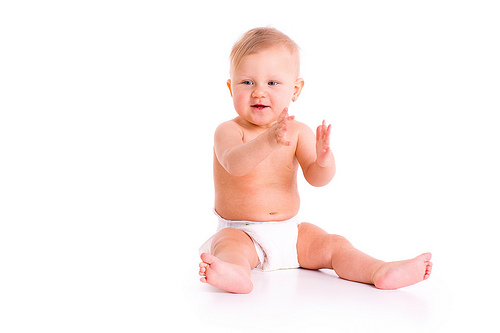April 25th, 2023

Parents, and even older children, can become concerned about tooth development. Wondering when teeth should erupt, and being concerned when the teeth do not appear on schedule, is common. First, you need to remember that each individual is different. Guidelines are just guidelines, but Dr. Irwin Seidman and our team at Palatine Pediatric Dentistry thought we would pass on this information to help you.
Primary teeth
Children normally have 20 primary or baby teeth. The first two to appear are usually the lower central incisors between six to ten months of age. These fall out between five and seven years of age.
- Two upper central incisors – eight to 12 months
- Two upper lateral incisors – nine to 13 months
- Two upper cuspids or canines – 16 to 22 months
- Two upper first molars – 13 to 19 months
- Two upper second molars – 25 to 33 months
- Two lower lateral incisors – ten to 16 months
- Two lower cuspids or canines – 17 to 23 months
- Two lower first molars – 14 to 18 months
- Two lower second molars – 13 to 31 months
As you can see, all the primary teeth normally have erupted before three years of age, but the timeline can vary by four to six months. Except for the lower central incisors and second molars, upper teeth tend to appear before lower teeth.
Permanent or adult teeth
Adults normally have 32 permanent teeth. However, four of these are wisdom teeth or third molars, which are often removed.
- Two upper central incisors – seven to eight years
- Two upper lateral incisors – eight to nine years
- Two upper cuspids or canines – 11 to 12 years
- Two upper first premolars or bicuspids – ten to 11 years
- Two upper second premolars or bicuspids – ten to 12 years
- Two upper first molars – six to seven years
- Two upper second molars – 12 to 13 years
- Two upper third molars or wisdom teeth – 17 to 21 years
- Two lower central incisors – six to seven years
- Two lower lateral incisors – seven to eight years
- Two lower cuspids or canines – nine to ten years
- Two lower first premolars or bicuspids – ten to 12 years
- Two lower second premolars or bicuspids – 11 to 12 years
- Two lower first molars – six to seven years
- Two lower second molars – 11 to 13 years
- Two lower third molars or wisdom teeth – 17 to 21 years
Please discuss any of your dental concerns during your visit with Dr. Irwin Seidman. If there is a problem with tooth development, the earlier we address it, the better the outcome. We specialize in pediatric dentistry and look forward to helping you and your child with all your dental needs. To learn more about tooth eruption, or to schedule an appointment with Dr. Irwin Seidman, please give us a call at our convenient Palatine, IL office!
April 25th, 2023

Great question! Baby bottle tooth decay is the development of cavities caused by the frequent and long-term exposure of a child's teeth to liquids containing sugars. These liquids include milk, formula, fruit juice, sodas and other sweetened drinks. The bacteria in the mouth thrive on this sugar and produce acids that attack the infant's teeth and gums. After numerous attacks, tooth decay can begin.
The first rule is to make sure your child does not fall asleep with a bottle containing milk, formula, juice or other sweetened liquids. Giving an infant a sugary drink before bedtime is harmful because the flow of saliva decreases during sleep, allowing the sugary liquids to linger on the child's teeth for an extended period of time. If left untreated, pain and infection can result.
So, how can you prevent baby bottle tooth decay? Be sure to clean and massage the baby's gums once a day to help establish healthy teeth and to aid in teething. When brushing your child's teeth, use a soft toothbrush, as well non-fluoride toothpaste. Once your little one is able to spit, around the age of two, you should begin using fluoride toothpaste. From the beginning, have your little one practice spitting the toothpaste out after brushing. That way, he or she will already have the good habit of spitting when you switch to fluoride toothpaste, which should never be swallowed.
Also, be aware that children should visit Palatine Pediatric Dentistry when they are between six and 12 months old. Please give us a call if your child hasn't visited our Palatine, IL office in the last six months!
April 5th, 2023

Your bright smile means you’re happy, and it’s catching! Sharing your smile makes the people around you happy, too! And you can make sure your smile is as bright as it can be by keeping your teeth their cleanest.
Nobody wants food stuck in between their teeth, but cleaning your teeth doesn’t just mean brushing away any leftover bits of food. It also means brushing away the sticky plaque that builds up on your teeth every day. Germs in plaque called bacteria help make cavities, so it’s extra important to brush and floss away all the plaque you can.
When you were younger, a grown-up cleaned your teeth for you. Now that you’re ready to begin brushing and flossing on your own (with some adult help, of course), here are some good habits to start you off right.
Brush the Right Way
- Brush a tooth or two at a time with small brushstrokes and circles. Long back-and-forth brushstrokes miss a lot of plaque. Make sure you brush all the different sides of your teeth, not just the ones which show when you smile. Brush on the inside of your teeth and the tops of your molars (those big teeth in back). Use up-and-down strokes to clean behind your front teeth.
- Tip your toothbrush toward your gums while you brush along the gum line to get the plaque that likes to hide there.
- Don’t scrub your teeth. The tooth enamel that covers and protects our teeth is very strong, but brushing too hard can hurt it. Gentle brushing works!
- And don’t forget to gently brush your tongue for fresh breath.
Take Your Time
- You can’t keep your teeth their cleanest if you don’t spend enough time brushing them! That’s why dentists say it’s best to brush at least twice each day, for two minutes each time you brush.
- It’s hard to guess how long two minutes is, so use a little timer to keep track of the time. If you like music, play a song that lasts two minutes. Or ask a grown-up to time you—and maybe even brush with you!
Use the Right Toothbrush
- You want a brush that is just the right shape and size. A brush which is too big is hard to use—and hard to fit inside your mouth.
- You want a brush with soft bristles. Medium and hard bristles are too hard, and can scrape your enamel and gums. Stay with soft bristles, and your teeth and gums will be healthy and happy.
- Toothbrushes don’t last a very long time because their bristles start to break down after a while. After all, it’s hard work cleaning teeth twice a day every day! So it’s a good idea to change your toothbrush every three or four months, or whenever the bristles start to look a bit scruffy.
Use the Right Toothpaste
- Fluoride toothpaste helps protect your teeth from cavities and makes your enamel even stronger than it already is. There are plenty of fun-flavored fluoride (say that three times fast!) toothpastes to choose from.
- You don’t need too much. Once you’re brushing on your own, a small dab about the size of a pea will do the trick.
- Be sure to spit out the toothpaste after brushing. It’s for cleaning, not swallowing!
Don’t Forget to Floss
- Once you have any teeth that touch each other, you need to floss between them at least once a day. Flossing is the best way to get rid of the plaque that hides between your teeth where your brush just can’t reach.
- Flossing can be a little tricky at first, so you might need some help until you’re able to floss on your own. Dr. Irwin Seidman can teach you the best way to floss, and a grown-up at home can help you until you’re ready to floss by yourself.
- There are lots of different kinds of floss. If you’re having trouble flossing, ask our Palatine, IL dental team which kind is best for you.
Every smile is different, and yours is one of a kind. If you have any questions, talk to your pediatric dentist. Dentists don’t just take care of your teeth—they teach you to take care of your teeth, too! Your dentist can show you the very best way to keep your very own smile as bright and healthy as it can be.
April 5th, 2023

One of the most frequent questions that Dr. Irwin Seidman and our team hear is about what kinds of snacks are best for a child’s dental health. Sugary snacks are inevitable sometimes, but it’s vital for you as a parent to monitor how frequently your child is eating the kinds of snacks that may give him or her a cavity or two down the line.
Unsurprisingly, the best snacks are healthy ones, though they may not always be the most appealing to your little ones. The good news is that healthy doesn’t mean you have to compromise on taste. Once your kids give these tasty snacks a go, they might become open to all things healthy!
- Fresh veggies and hummus
- Apple wedges with peanut butter
- Low-fat yogurt with berries
- Cubes of cheese and crackers
- Hard-boiled eggs with a little bit of salt and pepper
- Celery sticks with cream cheese and sunflower seeds
- A homemade milkshake with low-fat milk (or almond milk), the fruit of their choice, chia seeds, and cinnamon
- Lean proteins such as chicken breast, fish, and turkey
These snacks aren’t high in sugar but they contain all the nutrients your children need to have the necessary energy throughout the day.
This is only a sample of all the great, healthy snacks out there for your kids. For more ideas, ask us the next time you visit our Palatine, IL office. It’s never too early to create healthy habits; they’re not only good for oral health, but overall health too. That’s a win-win, if you ask us.






 Website Powered by Sesame 24-7™
Website Powered by Sesame 24-7™